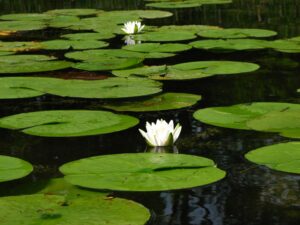Introduction
Aquatic plant management: an introduction
 Aquatic plants (and other life such as blue green algae) provide oxygen as a byproduct of photosynthesis. Some are a major food source for lake organisms, help stabilize bottom sediments, and help prevent shoreline erosion. Most water plants in lakes are native, such as wild celery, coontail, and large leaf pond weed, while some are invasive species, such as curly-leaf pondweed, Eurasian watermilfoil and starry stonewort. While most aquatic plant populations do not cause a problem, the natural density and distribution of aquatic plants in lakes and streams can become disrupted when either 1) excess nutrients cause native or invasive plants to have abnormally high growth rates and/or 2) invasive aquatic weeds are introduced and out-compete native lake plants.
Aquatic plants (and other life such as blue green algae) provide oxygen as a byproduct of photosynthesis. Some are a major food source for lake organisms, help stabilize bottom sediments, and help prevent shoreline erosion. Most water plants in lakes are native, such as wild celery, coontail, and large leaf pond weed, while some are invasive species, such as curly-leaf pondweed, Eurasian watermilfoil and starry stonewort. While most aquatic plant populations do not cause a problem, the natural density and distribution of aquatic plants in lakes and streams can become disrupted when either 1) excess nutrients cause native or invasive plants to have abnormally high growth rates and/or 2) invasive aquatic weeds are introduced and out-compete native lake plants.
Invasive species cause most of the nuisance problems in larger waterways and often produce widespread dense beds that obstruct navigation, recreation, fishing and swimming. In addition, dense nuisance pond weeds increase the likelihood of flooding and aid in the spread of insect-borne diseases. Invasive plants can also reduce both water quality and property values for shoreline owners. When the presence of invasive aquatic plants have a negative impact on the ecology or recreational use of a lake, some lake associations and/or individual property owners (hereafter, “stakeholders”) make the decision to undertake aquatic plant management.
The goal of invasive aquatic plant management is to preserve or restore ecologically stable aquatic communities and recreational enjoyment. An aquatic plant management plan, as part of a lake management plan, will help meet this goal. A variety of factors will influence whether this goal is best achieved through monitoring, containment, reduction/nuisance lake weed control, or eradication efforts. A lake management service provider can help the stakeholders understand these factors and make decisions on how best to proceed. The state’s natural resource agency is also a good resource for technical advice on the management of nuisance and invasive aquatic plants. Aquatic plant management has several stages. First, it is important to understand the status of the invasive plants: for example, which plants are there, where they are, the area they cover, and whether they are increasing. This stage includes developing an aquatic plant management plan and surveying the lake. Once the current status of the invasive plants is better understood, stakeholders can decide to address the issue. One option is to monitor the lake plants. While less common than treating the plants, monitoring is an important step to understanding if and how the plant populations are changing. For example, if they are not expanding, control treatments may not be necessary. If planning and monitoring indicates the plants are at high levels and growing, the next option is controlling these plants using one or more treatment strategies. These strategies can include aquatic herbicides (i.e. aquacide pellets, diquat, etc) , mechanical/physical, and biological strategies. See the “Management plans” fact sheet for more information on developing an aquatic plant management plan.
Perhaps the most important fact to keep in mind is that there is no ‘silver bullet’ to treating invasive aquatic plants. Although lake management options have improved, current practices can only reduce populations to low(er) levels and often require annual maintenance and/or repeated treatments – very few are able to completely eradicate an undesired lake weed species. While herbicide treatment is the most common approach for invasive aquatic plants, integrated aquatic weed control strategies (e.g., that combine chemical, mechanical/physical, and/or biological methods) are often more effective than a single strategy.